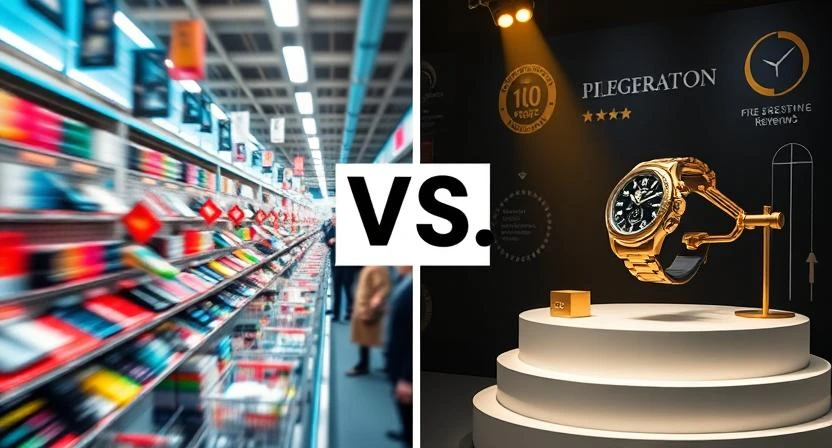Every day, thousands of e-commerce entrepreneurs wake up frustrated. They are running ads, updating product pages, and tweaking their funnels. Yet their bank accounts tell a different story. The sales are not adding up. The profit margins are thin. And somehow, despite all the effort, the business feels like it is barely staying alive.
Here is the uncomfortable truth: the problem is not your product. It is not your niche. It is not even your marketing budget. The real issue is that you are operating in the wrong business model, strategy, or worse, you are mixing two completely different models and expecting them to work together. Understanding the difference between high volume and high margin e-commerce is not optional anymore. It is the foundation of whether your store will thrive or slowly bleed money until you quit.
Let me break this down in the simplest way possible, so you can finally stop spinning your wheels and start making real progress.
The Two Core E-Commerce Business Models Explained
At the heart of every successful online store, there are only two fundamental approaches: high volume and high margin. Both models work. Both can generate serious revenue. But they operate on completely different principles, require different strategies, and attract different types of customers.
Think of it like choosing between running a fast-food restaurant or a fine-dining establishment. Both feed people. Both make money. But the way they operate, the customers they serve, and the strategies they use are worlds apart.
High volume e-commerce is all about moving large quantities of products quickly. Your profit per unit is relatively small, but you make up for it by selling hundreds or thousands of units daily. Think phone cases, beauty products, pet accessories, or kitchen gadgets. These are typically low-ticket items priced under $50.
High margin e-commerce is the opposite. You sell fewer units, but each sale brings in substantial profit. These are premium products like luxury watches, high-end electronics, professional fitness equipment, or artisan jewelry. Prices often start at $200 and can climb into the thousands.
According to research from Shopify’s 2024 Commerce Trends Report, stores operating in the high-margin segment reported an average order value (AOV) of $287, compared to just $68 for high-volume stores. However, high-volume stores processed 4.3 times more transactions monthly on average.
The key takeaway here is simple: neither model is better than the other. What matters is knowing which lane you are competing in and executing the right strategy for that lane.
How Your Pricing Strategy Determines Your Business Model
Your price point is not just a number you slap on a product page. It is a strategic decision that dictates everything about how your business must operate. When you price a product at $12, you are automatically entering the high-volume game. When you price it at $500, you have stepped into the high-margin arena.
Let me give you a practical example. If you sell generic sunglasses for $15 with a $6 profit margin, you would need to sell 167 pairs just to make $1,000 in profit. That requires significant traffic, consistent advertising, broad audience targeting, and a simple, friction-free checkout process.
Now, if you sell premium polarized sunglasses for $180 with a $90 profit margin, you only need 12 sales to hit that same $1,000 profit. But to convince someone to spend $180 on sunglasses, you need exceptional product photography, detailed descriptions, customer testimonials, influencer endorsements, and a persuasive brand story.
Many business owners make critical financial decisions without fully understanding these dynamics. Just like you need solid strategies when it comes to managing student loan repayments, you need clarity on which e-commerce model aligns with your resources and goals.
Same profit target. Completely different execution requirements.
The High-Volume Model: Speed, Automation, and Traffic Generation
If your products fall into the low-ticket category, your entire business must be built around velocity. You need traffic, lots of it, and you need systems that can handle large order volumes without breaking down.
Here is what success looks like in the high-volume model:
Your advertising strategy should focus on broad targeting. You are not trying to convince a specific niche. You are casting a wide net because your product appeals to a general audience. Someone scrolling through social media sees your ad, thinks “that is cool,” and buys it within seconds. The decision-making process is short because the financial risk is low.
Your product pages should be simple and straightforward. People buying a $20 phone case do not need a 2,000-word sales letter. They need clear photos, a simple description, fast loading times, and a quick checkout process. According to Baymard Institute’s 2024 study, 70% of mobile shoppers abandon carts due to complicated checkout processes, and this percentage is even higher for impulse purchases under $30.
Your ad creatives need constant refreshing. High-volume products face more competition, which means ad fatigue sets in quickly. You should be testing new images, videos, and copy weekly. The goal is to maintain attention and prevent your audience from scrolling past your ads.
Your profit comes from scale. A $7 profit per unit means nothing if you only sell ten units. But if you sell 300 units daily, that is $2,100 in daily profit. The math only works when you reach high transaction volumes. This is why automation tools, reliable suppliers, and streamlined fulfillment processes are non-negotiable in this model.
Think of brands like Shein or AliExpress sellers who move massive product quantities. Their success is not in convincing you their product is the best. It is in being everywhere, all the time, with prices so low that buying feels like a no-risk decision.
However, chasing volume without financial discipline is dangerous. Many entrepreneurs experience this when they fail to control their spending habits. Learning how to stop emotional spending and master financial discipline becomes essential, both personally and in business budgeting.
The High-Margin Model: Authority, Credibility, and Customer Lifetime Value
Now let us flip the script. If you are selling premium products, your entire approach must shift from volume to value. You are not trying to convince everyone. You are trying to convince the right people that your product is worth the investment.
High-margin success depends on trust signals. When someone is about to spend $800 on a smartwatch or $1,200 on a camera, they are not making an impulse decision. They are researching. They are comparing. They are looking for reasons to believe your product delivers on its promises.
This means your product pages must be comprehensive. You need detailed specifications, professional photography, video demonstrations, customer reviews, warranty information, and clear return policies. Every element should communicate quality and reliability.
Your marketing strategy should focus on education and authority. Instead of running generic ads saying “Buy Now,” you create content that positions your brand as an expert. Blog posts, comparison guides, how-to videos, and case studies all build credibility. When someone finally clicks “Add to Cart,” they have already been nurtured through your content ecosystem.
Your customer acquisition cost (CAC) will be higher, but so is your customer lifetime value (CLV). A customer who buys a $600 product is more likely to return for accessories, upgrades, or complementary products. According to research from Invesp, increasing customer retention by just 5% can boost profits by 25% to 95%, especially in high-margin categories.
Your advertising should use precise targeting. You are not chasing millions of impressions. You are targeting specific demographics, interests, and behaviors that align with your ideal customer profile. Retargeting becomes crucial because high-ticket purchases rarely happen on the first visit.
Think about brands like Apple, Rolex, or even premium Shopify stores selling professional camera equipment. They do not compete on price. They compete on brand reputation, product quality, and the experience they deliver. Someone buying an iPhone is not just buying a phone. They are buying into an ecosystem, a lifestyle, a sense of belonging.
This principle mirrors smart investing strategies. Just as you would not throw all your money into one stock, successful e-commerce requires understanding where your efforts yield the best returns. Building a diversified portfolio using low-cost ETFs requires the same strategic thinking as building a sustainable high-margin e-commerce business.
Where Most E-Commerce Sellers Go Horribly Wrong
The biggest mistake is not choosing the wrong model. It is trying to operate in one model while using strategies from the other.
I see this constantly. Sellers trying to move premium products with low-quality tactics. They are selling $400 fitness equipment but using poorly designed Facebook ads, generic product descriptions, and product pages that look like they were built in 2010. Then they wonder why nobody is buying.
On the flip side, I see sellers trying to sell $18 products as if they were luxury items. They invest heavily in one ad creative, expect it to run for months, and assume they can survive on 15 sales per day. They are shocked when they cannot cover their ad spend.
Here is the brutal reality: if you are selling low-ticket products and you are not generating at least 50+ orders daily, you are not running a high-volume business. You are running a hobby. The math simply does not work at low volumes with low margins.
Similarly, if you are selling high-ticket products without social proof, trust signals, or a solid conversion funnel, you are asking customers to gamble with their money. And most people will not take that bet.
This is similar to common mistakes in trading. Many traders lose money not because they lack knowledge, but because they apply the wrong strategies at the wrong time. Understanding the top mistakes traders make that cost them money can help you avoid similar errors in e-commerce execution.
The Real Formula: Matching Strategy to Model
Success in e-commerce is not about working harder. It is about working smarter within the framework of your chosen model.
If you are in the high-volume game:
- Focus on traffic generation and conversion rate optimization
- Test multiple ad creatives weekly
- Simplify your checkout process
- Use broad audience targeting
- Prioritize speed and automation over perfection
- Track metrics like conversion rate, cost per acquisition, and daily order volume
If you are in the high-margin game:
- Build authority and credibility first
- Invest in high-quality content and product presentation
- Use retargeting and email nurture sequences
- Target specific customer segments
- Focus on customer lifetime value, not just first purchase
- Track metrics like average order value, customer retention rate, and profit per customer
The inputs are different. The marketing strategies are different. The revenue metrics are different. Even the mindset and daily execution are different.
One model rewards speed and scale. The other rewards patience and positioning. Trying to merge them is like planting yams and expecting them to hatch chickens. It does not work that way.
Modern business decisions increasingly involve understanding different asset classes and their behaviors. For instance, comparing tokenized real estate versus traditional mortgages requires understanding two fundamentally different investment frameworks, just like high volume and high margin e-commerce.
Stop Guessing, Start Executing
If your e-commerce business is not where you want it to be, I challenge you to honestly answer this question: Do you truly know which model you are operating in, and are you executing strategies that align with that model?
Most sellers fail not because of bad products or tough competition. They fail because they are applying the wrong business framework. They are putting in effort with misplaced focus, wondering why hard work is not translating into results.
The good news is that once you identify your model and commit to the right execution strategy, progress becomes inevitable. Clarity eliminates confusion. Focus eliminates wasted effort. And proper execution eliminates excuses.
Choose your lane. Master the strategies for that lane. Execute relentlessly. That is the formula.
Because at the end of the day, both models work. But only when you stop mixing them and start executing correctly.

